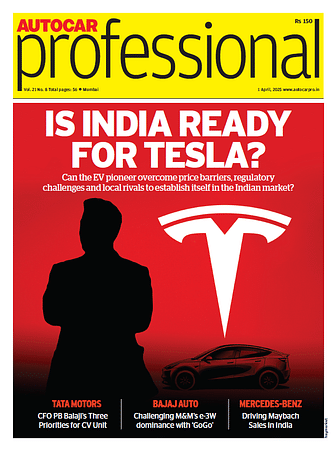CV Retail Sales Face Headwinds IN March Despite Modest Growth
Heavy Commercial Vehicles (HCV), typically considered the barometer of economic activity, saw a decline of 4.87%, indicating continued pressure in the long-haul transportation sector.
Commercial Vehicle (CV) retail sales showed signs of recovery in March 2025, registering a moderate 2.68% year-over-year growth with 94,764 units sold compared to 92,292 units in March 2024, according to data released by the Federation of Automobile Dealers Associations (FADA). This positive end to the fiscal year provides a glimmer of hope for a segment that has struggled with consistent performance throughout the year.
Despite the March uptick, the CV segment closed FY2025 with a marginal decline of 0.17% compared to the previous fiscal year, highlighting the persistent challenges faced by the commercial transportation sector in India.
The monthly growth data reveals a fluctuating pattern in the commercial vehicle segment, with seven out of twelve months showing negative growth. The segment experienced its lowest point in September 2024 with a 10.45% decline, while
January 2025 marked the highest growth at 8.22%. This seesaw pattern reflects the segment's struggle to maintain consistent growth amid various economic and sector-specific challenges.
"CV dealerships reported moderate 2.68% YoY growth, with a robust 14.5% MoM upswing in March," explained Mr. C.S. Vigneshwar, FADA President. "Gudi Padwa deliveries, supportive financing, and infrastructure activity elevated customer footfall. However, major hurdles included aggressive targets and uneven product availability."
Segment Performance Analysis
Looking deeper into the commercial vehicle category, Light Commercial Vehicles (LCV) outperformed in March with a 5.57% YoY growth, while Medium Commercial Vehicles (MCV) showed the strongest performance with a 12.43% increase.
However, Heavy Commercial Vehicles (HCV), typically considered the barometer of economic activity, saw a decline of 4.87%, indicating continued pressure in the long-haul transportation sector.
"The varying performance across CV sub-segments reflects the complex market dynamics at play," noted Vigneshwar. "While school bus demand and last-mile delivery vehicles have shown strength, the core HCV segment continues to face headwinds from sluggish industrial activity and freight overcapacity."
Market Leader Movements
Tata Motors maintained its leadership position despite seeing its market share contract to 32.16% in March 2025 from 36.05% a year earlier. Mahindra & Mahindra strengthened its position, growing to 25.51% from 23.64%, while Ashok Leyland held steady with a slight increase to 17.27% from 16.74%.
A notable development was the performance of Force Motors, which saw its market share grow significantly to 2.84% in March 2025 from 1.69% in the same month last year, highlighting the growing diversity in the CV market landscape.
Urban versus Rural Divide
Unlike the two-wheeler and passenger vehicle segments, commercial vehicles showed a more nuanced urban-rural split. Urban CVs posted growth of 7.61% YoY in March, while rural areas experienced a 2.18% decline. For the full fiscal year, urban areas registered a small positive growth of 0.55%, while rural markets contracted by 0.90%.
"The urban-rural divide in CV sales reflects the different economic realities across India," explained Vigneshwar. "Urban infrastructure projects, e-commerce delivery demand, and school bus segment growth have supported urban CV sales, while rural areas have struggled with slower economic activity and limited financing options."
Challenges and Future Outlook
Looking forward to FY2026, FADA anticipates low single-digit growth for the CV segment. Several factors are expected to influence the market, including the pace of infrastructure project execution, industrial output, and agricultural performance.
The introduction of new emission norms and potential price increases could also impact purchase decisions, particularly in the price-sensitive small and medium fleet operator segment.
"While we remain cautiously optimistic about the CV segment's growth prospects, we're closely monitoring several risk factors," said Vigneshwar. "Financing availability continues to be a critical determinant of CV sales, and we hope to see improvements in this area to support growth."
The commercial vehicle industry also continues its transition toward alternative fuels and electric options, with EV penetration in the CV segment reaching 1.0% in March 2025. Although this represents a decline from 2.3% in March 2024, the overall trend points toward gradual electrification, particularly in urban public transportation and last-mile delivery applications.
The commercial vehicle sector's performance in March provides a positive note to end a challenging fiscal year. However, the consistent month-to-month volatility suggests that the road to sustained recovery remains bumpy, with multiple economic and sector-specific factors continuing to influence demand patterns.
RELATED ARTICLES
Remsons Industries Acquires 51% Stake in Electric Three-Wheeler Maker Astro Motors
The Rs. 14.22 crore acquisition marks Remsons' entry into the growing electric vehicle market, targeting the expanding l...
Olectra Greentech Secures ₹424 Crore Order from Himachal Road Transport Corporation
The company will supply and maintain 297 electric buses in a deal valued at approximately ₹424.01 crores.
Greaves Cotton and Chara Technologies Join Forces to Develop Rare-Earth-Free Motors
Indian engineering giant partners with tech startup to manufacture sustainable electric motors for mobility solutions, a...






 By Shruti Shiraguppi
By Shruti Shiraguppi
 07 Apr 2025
07 Apr 2025
 1723 Views
1723 Views





 Angitha Suresh
Angitha Suresh


 Arunima Pal
Arunima Pal


